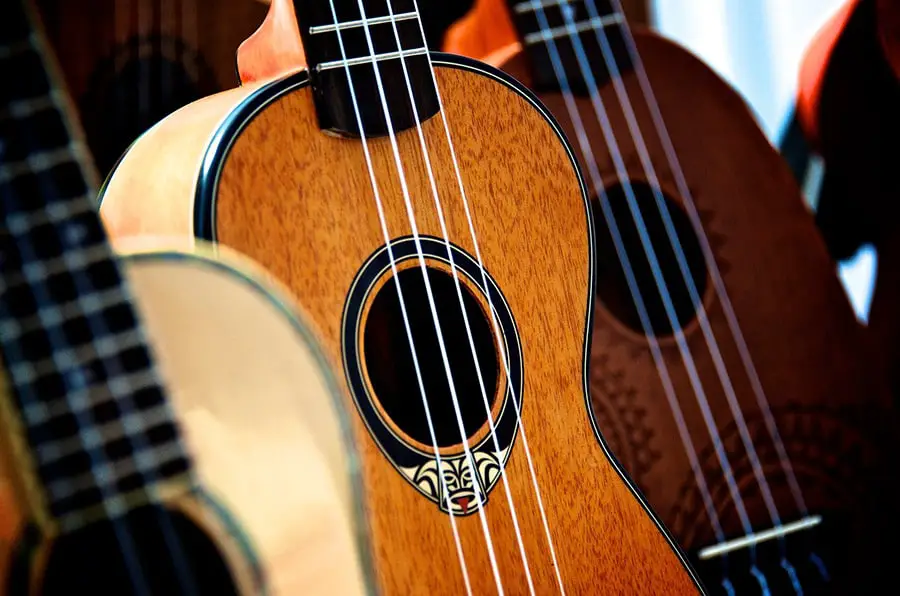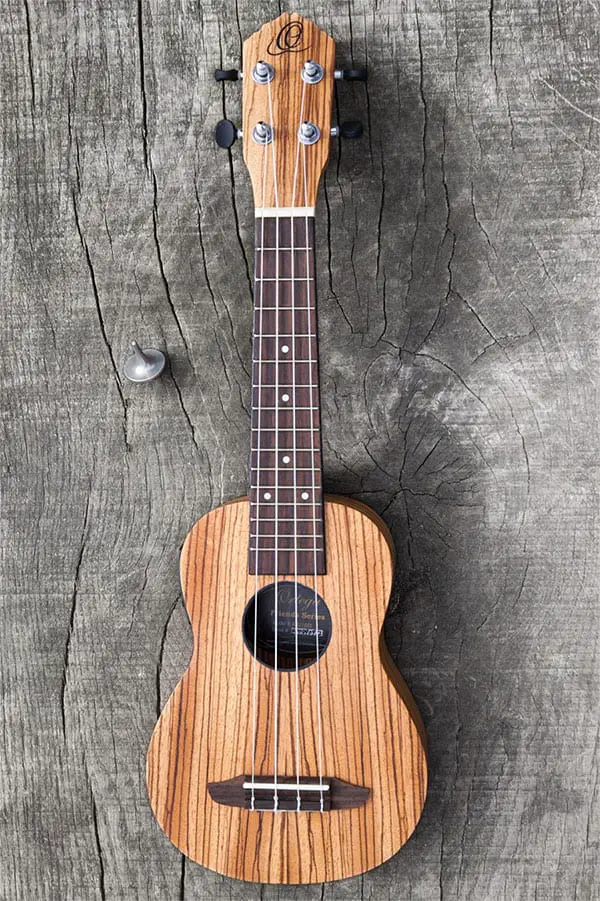Is It Easy to Learn the Ukelelex

Before deciding whether to learn the ukulele or not, asking "how hard it is" is a totally legitimate question.
Investigating the answer will help you set expectations, which will most likely positively influence your learning experience. At least it did for me!
So in a nutshell, how hard is it to learn to play the ukulele?
The ukulele is a really easy instrument to learn. Compared to a guitar, the uke has fewer strings and a smaller body size, so it's more manageable. It's a great option as a first instrument. If you have experience with other stringed instruments, it won't take long to master a ukulele.
Nevertheless, there are details you should know. And I'm going to share from my own experience and knowing many people who learned the ukulele as their first instrument.
As is the case with any instrument, you need time and patience to learn the ukulele. And if you have zero experience playing string instruments like guitar, it will be harder.
The uke can also act as a gateway. Once you've got the basics, you'll take to a guitar faster.
Personally. I found that my guitar experience allowed me to learn the ukulele without too much fuss. From the scaled-down dimensions to the smooth nylon strings—the uke is easier.
However, there are issues. When you play the guitar in standard tuning for some time, the chord shapes become instinctive.
So, the chord shapes on a ukulele take some memorizing. The G major on the ukulele is a similar shape to a D major on guitar. So, this chord, in particular, is troublesome.
So let's look at points of consideration that'll affect your learning of the ukulele.
7 Things That Impact How Hard it is to Learn the Ukulele

1. The Ukulele Size
You might already know that ukuleles come in 4 different sizes. These are the different types and their approximate size:
- Soprano: 21″
- Concert: 23″
- Tenor: 26″
- Baritone: 30″
So how does this affect learning?
Different players will feel comfortable with different sizes of ukulele.
A soprano is the smallest ukulele and a concert is the "medium" size. For most people, they're both a great size to kickstart learning the ukulele.
If you're broad or have large hands, a soprano or even concert can feel claustrophobic and uncomfortable. So a tenor will feel more natural to your shape.
A baritone ukulele is at the larger end of the scale. It uses a different tuning compared to other styles of ukulele which use gCEA tuning. So, refer to chord diagrams that show shapes specific to the lower DGBE baritone tuning.
The type and size of the ukulele can have a tremendous impact on the learning curve. Get one to suit your size and you'll start on the right foot.
2. The Ukulele Built Quality

Like many things in life—you pay for what you get.
Some of the cheaper instruments are of inferior quality. While they might look OK on the eye, playability can suffer. If the instrument is comfortable to play, learning will be easier.
There are plenty of factors that contribute to playability. But the action can be the biggest hindrance for a beginner.
The action of a ukulele relates to the distance between the strings and the fretboard. A cheap ukulele tends to suffer from poor action. This means that you'll need more pressure to form chords, thus being harder to play.
A good technique to find an excellent quality ukulele is to look at the tonewoods. If you see bodies made of mahogany, koa, maple, or rosewood, you are in the right ballpark.
3. How You Hold the Ukulele
So you've got your ukulele. What next? Well, pick it up. Simple right?
Not quite. If you don't get this right, you'll be struggling right from the start.
So how do you hold the ukulele? Although it's tempting to imitate rock gods, we don't advise a low-slung ukulele.
Coming from the perspective of a right-hander. Here are some points to get you started.
- Place it just below chest height. Use your right forearm to press the ukulele against your body. Think of a cradling arm to help you out.
- Use your left hand to hold the neck. With your thumb pressed on the back of the neck, curl your fingers towards the fretboard. Remember, you'll need to press the strings with enough pressure to play a note. So your thumb will do work here.
- With your right arm bent at the elbow, keep your wrist loose and brush the strings with a light action.
Tip: If you would prefer to use a strap. Buy a ukulele with strap buttons.
4. Learning Ukulele Strumming Patterns
If you start by attempting to fingerpick, it'll frustrate you.
Strumming is the best place to start. But even strumming patterns vary in difficulty.
Synchronizing chord shapes alongside strumming rhythm is hard for a newcomer. A rigid strumming arm can make learning even more difficult. Try to start the strumming movement from your upper arm but make sure the rest of your arm is relaxed and loose, especially your wrist.
Here are some strumming tips to make learning the ukulele less hard.
- For the beginner, a pick might make learning easier. Hold it between your thumb and index finger.
- Use a light pick when starting. A thin pick will allow for more movement. Try using picks with a thickness of .40 to .60 mm.
- Start with simple downstrokes and brush down on the strings.
- Once you've got the downstroke. Try using a metronome. A metronome will help you keep time and lock in a rhythm. These are available online or in an app for free. Start with a slow BPM.
- From there you can include some upstrokes to your pattern.
- When comfortable and you're feeling the rhythm, you can try some chord changes.
- The goal will be to play along with a song. With a few chords and strumming, you can attempt this.
Tip: Tap your foot to the rhythm of a song. This is a smart hack to keep time. For a song in 4/4 count the beat like this:
1 & 2 & 3 & 4 &
5. Many Easy Chords
A big factor in making learning the ukulele easier than the guitar is the chord shapes. Using the gCEA tuning, some chords use one finger. This is a good place to start if you want to learn the ukulele.
Learning chord shapes takes practice. Memorizing the shapes takes time and if you're new to playing a string instrument, you may not have much finger flexibility.
At the start, you might feel discomfort at your fingertips. Although the nylon strings are smoother than the steel strings on a guitar, they can still be a pain.
After a while, your fingers will form calluses. So, there is no more discomfort. A callus is a tough area of skin. This helps with your playing because your fingertips become desensitized.
Once you have calluses on your fingertips, playing the ukulele is easier. The more you play, the sooner you create calluses.
As you progress, you'll come across the barre chord. This is a chord that involves the index finger barring all four strings.
While it may seem daunting, it's much easier than a guitar. The closer frets and the fewer strings allow you to form a barre easier.
Here are some good chords to get you started:

6. Many Easy Song to Play
The barrier of entry to play your first songs on the ukulele is quite low. As long as you choose the right songs for beginnersé
We're talking about songs with not too many chords. With fewer chords, your brain won't go into overtime trying to remember shapes.
Also, the chords themselves matter. For instance, a song with two chords might sound appealing. But if those chords are complex shapes like barre chords, you'll find learning hard.
Here's a good list of songs for beginners. Ambition is a good thing, but be realistic and focus on a song off this list. This will make learning the ukulele more enjoyable and easier.
Whether you are a Belieber, or Bob Dylan is more your thing, There are easy songs for everyone.
7. Sing and Play Ukulele at The Same Time
So you've got the song, what about a little sing-along?
It can be very natural to sing along. Some may find it easy, while others may need more practice.
Singing alone requires a lot of skill. There's timing to consider, lyrics to remember, and of course, you'll want to sing in tune.
Coordinating singing and ukulele is difficult for an untrained brain to process. You may find your brain can only focus on one activity. This means you need to exercise your muscle memory to make it easier.
Here are a few tips to help you:
- Timing. If you're new, singing and playing a high-tempo song will be difficult. So pick a song with a lower tempo or play the song slower. A metronome can help you keep time. This way you'll be able to sing along to the tempo.
- Hum. Rather than go straight in a full Adele bellow. Try to hum or whistle along to the melody as you play. This will train the melody and then you can start incorporating words.
- Strumming pattern. Use a simplified strumming pattern like using downstrokes alone. This will allow the brain space to focus on singing.
- Practice parts separately. Play a song throughout on ukulele and then sing it back. You could always record the ukulele part on your phone and sing back to that. This will help familiarize you with the song.
- Lyrics. Have the lyrics on hand so you don't have to stop.
Conclusion
So, how hard is it to learn to play the ukulele?
Well, it depends. Your current skill level on stringed instruments is going to play a massive part. Also, the goals you set will make a difference. Do you want to play a few chords or play like a seasoned pro such as Vance Joy?
But whether you're aiming for the top of the charts or want to add a little creativity in your life. The ukulele is the instrument to start because it's one of the easiest to learn.
It can dishearten if you don't get it the first time—-but keep going and enjoy!
Hopefully, this article has supplied some helpful tips. Wishing you luck.
Happy strumming!
Anna teaches piano and guitar and also has extensive experience recording music. She's well read in music psychology and love to share the benefits of learning to play music.
weatherburnalaing.blogspot.com
Source: https://acousticrealm.com/how-hard-is-it-to-learn-to-play-ukulele